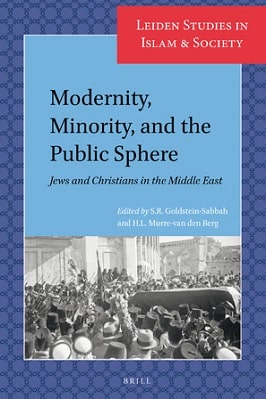
| Book Title | Modernity Minority And The Public Sphere |
| Book Author | Goldstein-Sabbah |
| Total Pages | 329 |
| Book Views | |
| Language | English |
| Book Download | PDF Direct Download Link |
| Get Hardcover | Click for Hard Similar Copy from Amazon |
Modernity Minority and the Public Sphere – Jews and Christians in the Middle East
Edited by S.R. Goldstein-Sabbah – H.L. Murre-van den Berg
MODERNITY MINORITY AND THE PUBLIC SPHERE
Searching for Common Ground: Jews and Christians in the Modern Middle East
In the late 1990s, the taxi driver of a Tehran cab changed the cassette tape to the engaging sounds of the Hebrew song Hava Nagilah (‘Let us rejoice’), a Jewish favourite for festive occasions.
Not quite knowing whether I was being provoked into anti- or pro-Israel sentiments, I somewhat cowardly indicated approval without asking for details. While the tape played on, the conversation was not pursued further, and I later asked some Iranian friends what they made of it.
They laughed at my discomfort and told me Israeli music was quite popular in Tehran and easily procured at the bazaar. As long as politics were kept out of it, the culture of the archenemy was not a problem.
It was only later that I learned about the thriving music culture in Iran and in the Arab Middle East of which Jews and Christians formed an intrinsic part. Especially in Iran, Jewish ensembles were popular among all classes of the population and Hava Nagilah was often performed at weddings, even after the majority of Jews left Iran in the years following the Islamic Revolution.
While the link between this earlier musical scene and the 1990s interest in Israeli music is perhaps an indirect one, both phenomena point to music as a locus of interaction and sharing even between communities that are antagonistic.
Often, this thriving and thoroughly mixed music culture has been quoted as an example of how people of different religious communities in the Middle East could live and party well together, sharing a common local culture.
The Tehran example indicates that this may have been too rosy a picture of how these societies functioned in the past and present, not only because shared cultural practices do not necessarily imply shared outlooks on society, but also because even seemingly innocent songs have political overtones that might not always be shared by those who pass them on, but which remain part of the song’s afterlife for those who want to see it.1 At the same time, cultural practices
To read more about the Modernity Minority And The Public Sphere book Click the download button below to get it for free
Report broken link
Support this Website
Click here to join our Telegram group for new Books